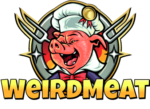Wildebeest Meat is a lean and low-fat meat that is lower in saturated fat and higher in polyunsaturated fatty acids than red meat. It is also an excellent source of protein, B vitamins and iron.
Traditional methods of food preservation are used to keep wildebeest, wart hog and other game meats fresh. They often include spices such as saltpetre, vinegar and sugar.
Overview of Wildebeest Meat as a Food Source
Wildebeests are a group of antelope species that live in the Serengeti plains of South-eastern Africa. They are light gray or brown with dark vertical stripes along their shoulders and a black mane.
They have curving horns on their heads that male herd leaders use to defend large territories and mate with females. They are usually docile animals but can be aggressive when they are in the mating season.
Females are pregnant for eight and a half months before giving birth to calves in February or March at the start of the rainy season. The timing of mating and birthing is determined by the dry and wet seasons, so that they have sufficient grass to eat during the lactation period.
Culinary Uses and Traditional Dishes
Wildebeest Meat is an excellent source of protein and can be used in a variety of culinary dishes. It is richer in flavor and leaner in fat than other meats.
The most common use for this meat is in stews and casseroles. It can also be grilled or broiled.
These meats are usually cured with vinegar, salt and sugar before being dried to prevent it from spoiling. Dry curing is a traditional method of food preservation in South Africa.
During their annual migration, wildebeest travel across Tanzania and Kenya in search of water and favorable grasses. Their large herds are a sight to behold, and the sheer numbers of animals crossing the savannas in the Serengeti and Mara creates a spectacle that few people will forget.
Availability and Market Trends
South Africa has a rich diversity of meat sources including domestic animals and wild game. Meat consumption in the country is mainly influenced by availability, price and the heritage and culture of its citizens.
However, the availability of Wildebeest Meat has declined in recent years due to hunting practices and the growing popularity of domestic meat. These changes are mainly driven by low-income consumers who prefer cheaper meats.
A new company in South Africa, Mogale Meat Co, is trying to tap into this demand with lab-grown meats. The company is developing a range of meats from wildebeest, springbok and impala without having to kill the animals.
Health Benefits and Concerns
Wildebeest meat has a number of health benefits, including a lower fat content and higher levels of omega-3 fatty acids. These are important factors because they help to reduce inflammation in the body, which is linked to a range of diseases and health conditions.
Another benefit of eating Wildebeest Meat is that it is high in iron, which is necessary for strong bones and muscles. In addition, it is low in saturated fat.
Black wildebeest are migratory animals that move from spring to autumn as they look for good grasses and pastures to feed on. They are herbivores and can be found in open plains, grasslands and Karoo shrublands.
Sustainability Issues
The excessive harvesting of wild animals for meat and the associated declines in many species pose a number of sustainability issues. These range from the conservation and livelihoods of those whose food and income are directly dependent on wildlife, to the health risks posed by eating high-fat, processed foods and diets lacking in fibre and fruit.
In South Africa, a start-up has recently developed a range of game meats that could be harvested without killing wild animals. Mogale Meat Co, which is based in a tourist town north of Johannesburg, says it could have its first product ready this year and launch commercially within three years.

